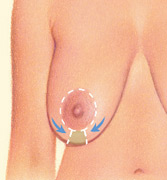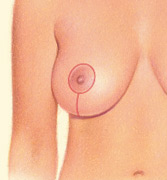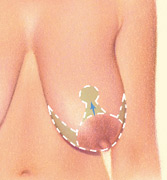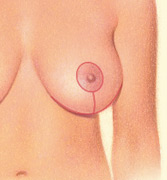Breast Lift
 A woman’s breasts may change in shape and size with time. Breasts may appear to become saggy and deflated. These changes may occur due to a number of contributing factors, such as pregnancy, breastfeeding, changes in weight, changes in skin elasticity, gravity and heredity.
A woman’s breasts may change in shape and size with time. Breasts may appear to become saggy and deflated. These changes may occur due to a number of contributing factors, such as pregnancy, breastfeeding, changes in weight, changes in skin elasticity, gravity and heredity.
Breast lift (Mastopexy), is a surgical procedure to raise and reshape sagging breasts. The operation itself is similar to the breast reduction surgery but without the removal of a large volume of breast tissue. The areola and nipple are repositioned above the inframammary fold and the breast is reshaped. The nipple is never detached from breast so sensation and function remain. Oftentimes, Dr. Thomas Crabtree—our board-certified plastic surgeon—may use an implant to further improve the appearance of the breast.
Choose a Breast Lift to:
- Restore and rejuvenate the breasts after pregnancy and nursing
- Reposition and elevate the nipples
- Reduce the size of the areolas
- Reposition, reduce and elevate sagging breasts
- Restore a more youthful look to breasts
Your Consultation
In the initial consultation, Dr. Crabtree will use the time to get to know you, learn about your expectations and discuss a plan to achieve your goals. He will discuss the variables of the surgery and create a custom approach for your procedure. Together you will decide if combining a breast augmentation with your breast lift will better achieve your goals. Prior to surgery you will have a good understanding of the procedure, plan and recovery.
Your Procedure
Your breast lift procedure generally takes about two to three hours and will be performed under general anesthesia administered by a Board-Certified Anesthesiologist or a Board-Certified Nurse Anesthetist at Windward Surgery Center in Kailua, Hawaii. Dr. Crabtree usually uses the Vertical Incision or the Wise Pattern Incision for his Breast Lift surgery.
Vertical Incision
A very popular option with both surgeons and patients is the vertical breast reduction. An incision is made around the areola and then continues vertically down the center of the lower half of the breast, giving this option its nickname, lollipop. An additional short, horizontal incision may be needed at the breast crease in some cases.
The vertical breast reduction can improve long-term breast shape and projection and is a great choice for some women. This technique may be for you if you have mild to moderately large breasts. This is not a good option for women with extremely large breasts.
This option produces shorter scars, but it includes some “bunching” of the skin along the lower half of the breast. The “bunching” usually flattens out over time, but an additional incision or a scar revision procedure may be required.
The vertical technique gives the surgeon less control than the anchor pattern reduction, but it may be a good choice for you if your breasts are not extremely large and you’re concerned about the scars associated with the anchor technique.


Wise Pattern Incision
Out of the 2 options we’ll be looking at, this is considered the gold standard of breast lift procedures. An incision is made around the areola and then continues down the center of the lower half of the breast, then an incision is made horizontally along the breast crease. The incisions form the inverted-t or anchor shape.
This is the most common breast reduction procedure because the skin can be moved vertically and horizontally on the breast. It allows your surgeon the greatest control of your breast shape and proportion because excess breast tissue can be removed from any part of the breast. This is the most versatile breast reduction technique available.
The one major drawback to consider when looking at this option is that it produces the longest scars. However, the scar in the breast crease is usually barely noticed by patients because of its location. If scars are a concern for you, or if you are prone to keloid scarring, another breast reduction technique may be preferable. Talk to your doctor to see if he can recommend the best technique to achieve the results you want with the least amount of scarring.


The Breast Lift Procedure
- Clinic Procedure or Operating Room: Operating Room
- Hospital Status: Outpatient
- Length of Surgery: 2-3 hours
- Anesthesia: General Anesthesia performed under the care of a board certified Anesthesiologist
- Post-Operative: A special bra may be worn for up to two weeks to help with swelling and recovery. Mild soreness, swelling, and bruising are all normal
- Recovery Time: Return to normal daily routine in one week, one month avoiding strenuous activity and several months for scars to fade and normal sensation.
- Results: The results will be evident immediately but will continue to improve and “settle” over the course of several months. The results will last for many years depending on lifestyle, childbirth, weight maintenance and other factors.

